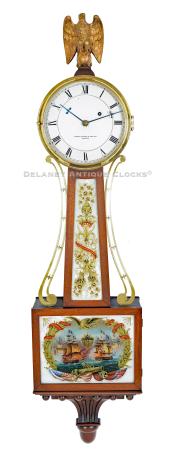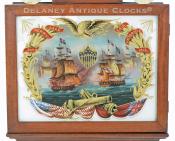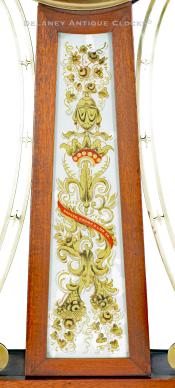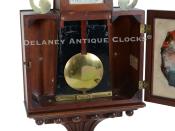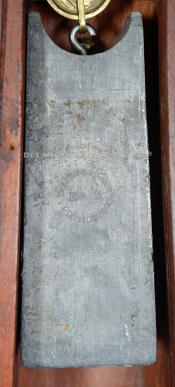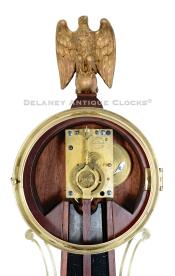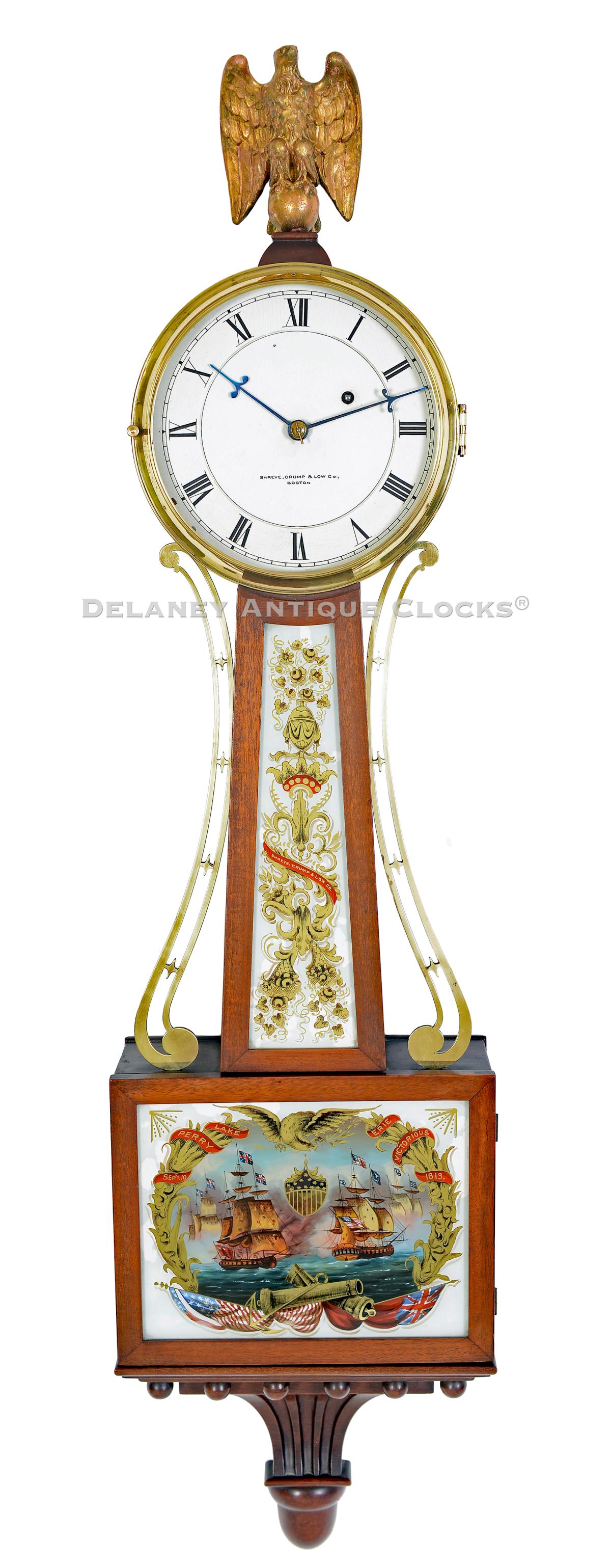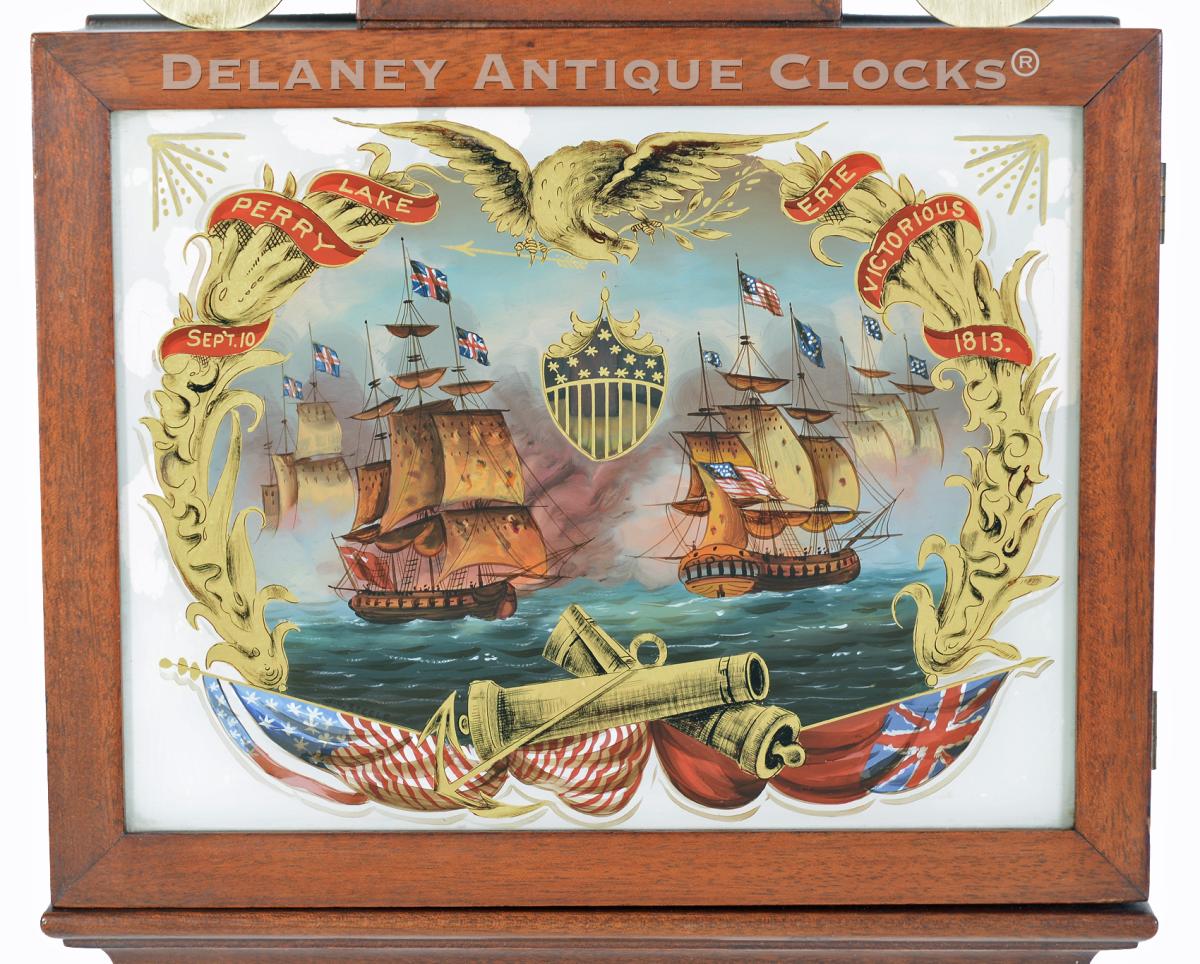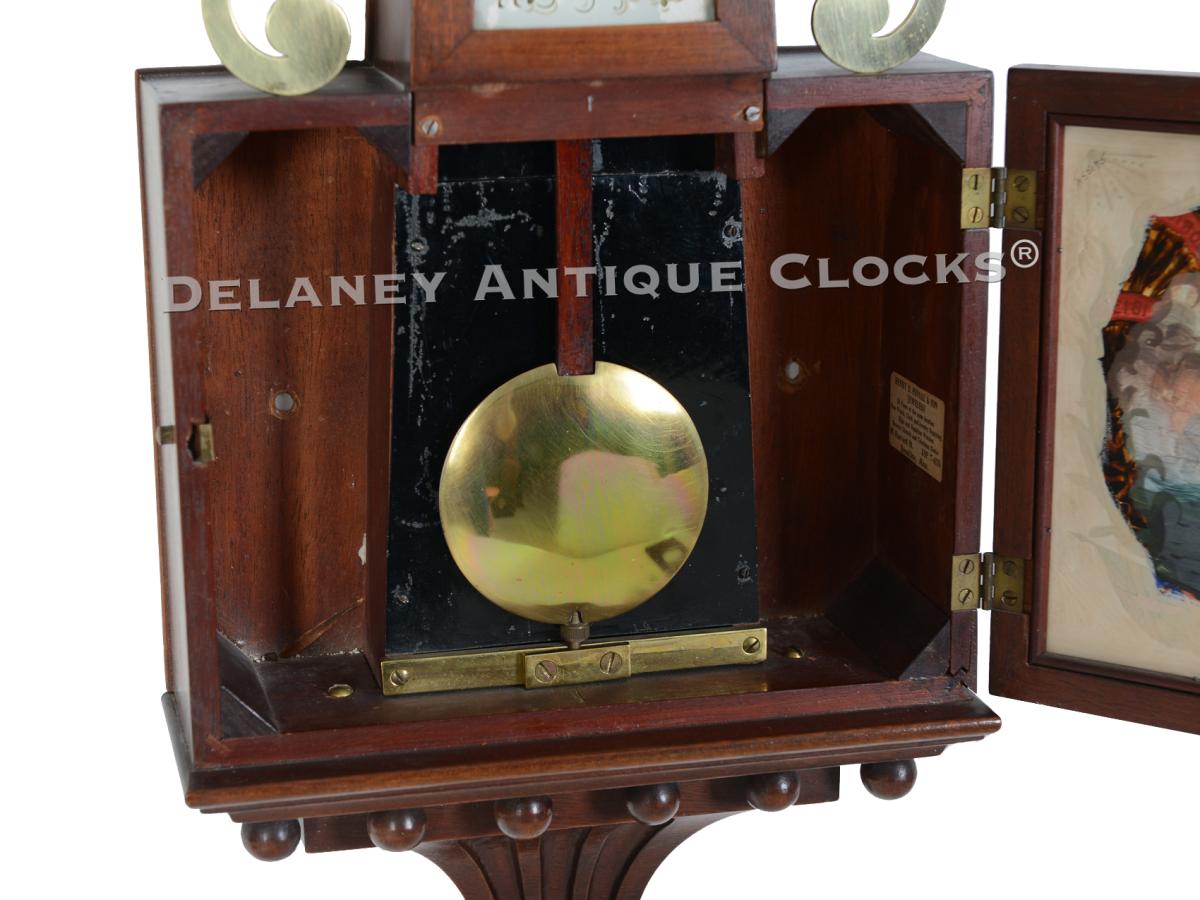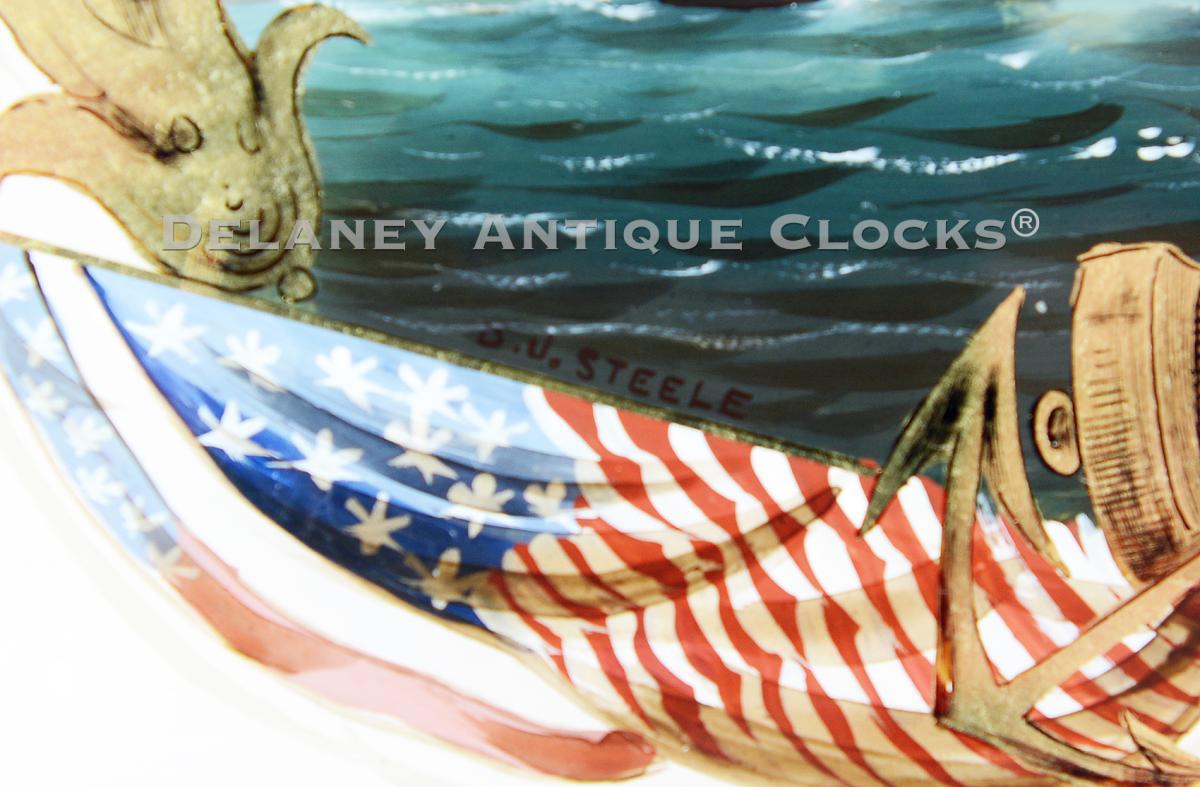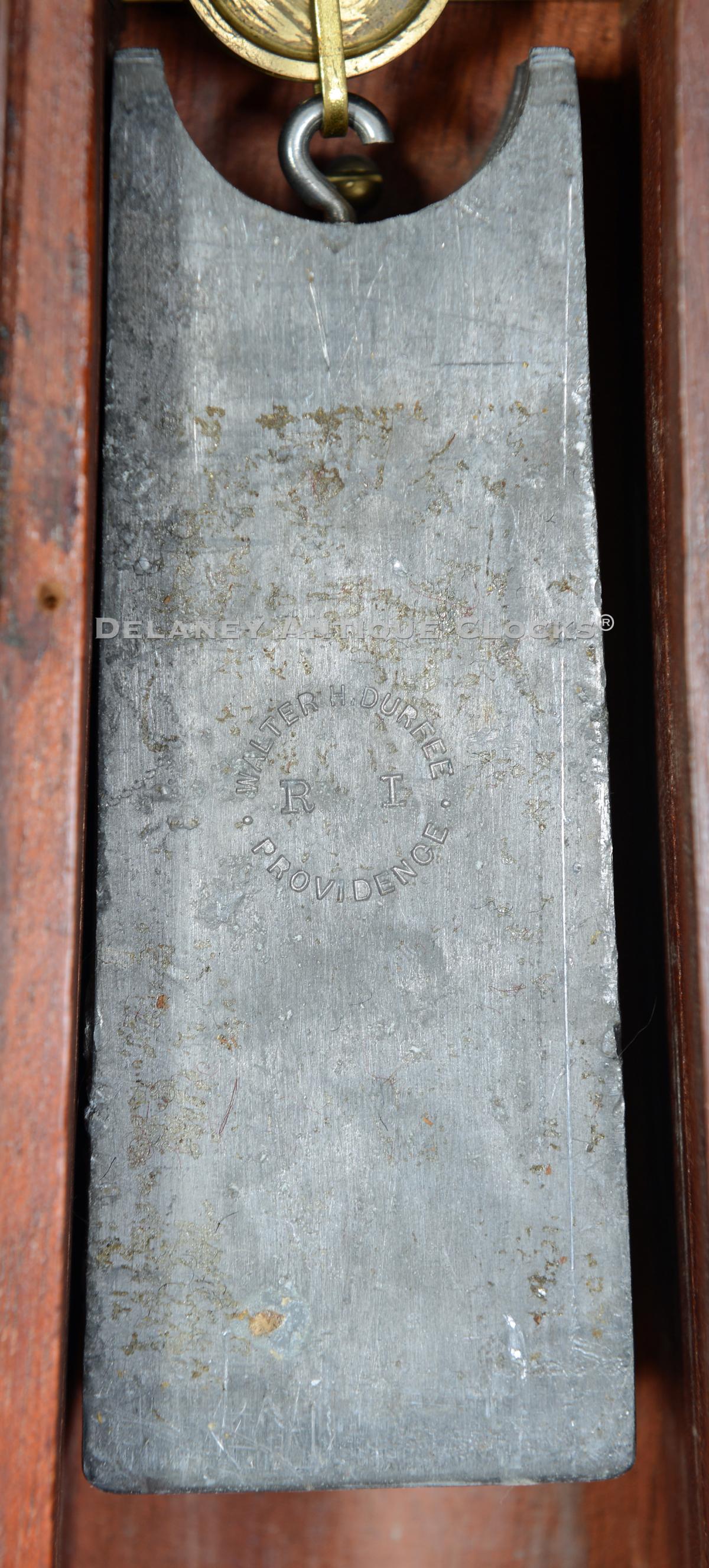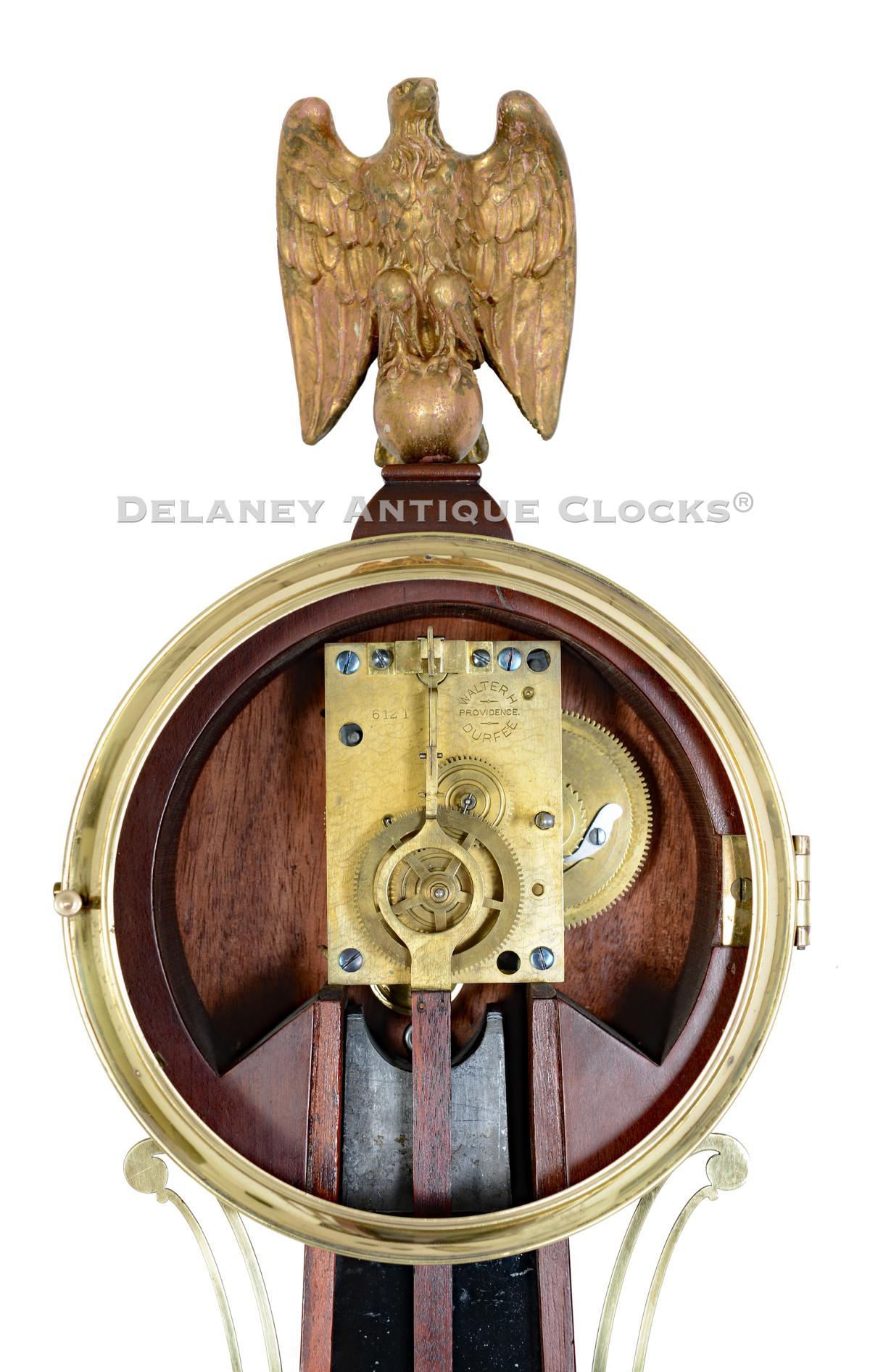Walter Durfee of Providence, Rhode Island. Wall Time Piece or Banjo Clock. Retailed by Shreve, Crump & Low Co., in Boston. Artist – D. J. Steele. 224070.
This is an outstanding example of a Federal Massachusetts Timepiece or "Banjo" clock made by Walter Durfee of Providence, Rhode Island, circa 1910. This timepiece was retailed in Boston by one of our nation's finest stores, Shreve, Crump & Low Co. What makes this example so outstanding is the presentation of the case and the coloring and artistry skill of the reverse-painted tablets.
The case is constructed in mahogany and retains its original finish. This model features a presentation bracket, flat mahogany veneered frames, brass side arms, a brass dial bezel, and a full figured eagle used as a finial. All of which are in excellent condition.
The reverse-painted tablets are hand-painted in excellent colors and demonstrate excellent skill. Both tablets are painted from the back. The throat tablet is decorated with traditional themes. Many first-period banjo clocks and throat glasses are often found with similar decorations. This example is signed "Shreve, Crump & Low Co." in the red banner. The lower tablet depicts a view of the Battle of Lake Erie, also known as the Battle of Put-in-Bay, which was a pivotal naval engagement between British and American forces off the shores of Ohio during the War of 1812. The artistry of this tablet is excellent. The artist signs this tablet on the lower left. The Artist's name is D. J. Steele.
March 12, 1888. He emigrated to Boston in the early 1900s. He is listed in the Boston Directories from 1903 through 1926. It is speculated that he learned his trade as an ornamental artist and reverse glass painting artist working at the William W. Spraque & Co. in Boston. This firm was known to provide reverse-painted glasses to the trades. One of their more prominent clients was the Waltham clock and watch businesses in Waltham, MA. Spraque & Co. offered numerous scenes; the most common are views of George Washington's residence, Mt. Vernon, Oliver H. Perry's Victory at Put-in-Bay, and the battle between the USS Constitution and the HMS Guerriere.
In 1906, D. J. Steele was listed as a dial and glass painter in the directories. In 1908, he advertised "D. J. STEELE, Dial and Glass Painting, Colonial Pictures Reproduced on Glass for Willard Clocks, Mirrors, Etc., Province Court Boston." Steele painted glasses for the Waltham Clock Co. and Walter Durfee. Steele authored the first article on Simon Willard's Banjo Clocks, published in February 1922 in Antiques Magazines. As a result, he became known as an expert on Willard clocks. Daniel filed an intention to marry Christine MacNell of Berkeley Street in Boston on June 16, 1911, in the Boston Globe. Christine learned painting on glass from her husband and continued the business after Daniel died in 1927 in Milton.
Daniel J. Steele was undoubtedly one of his day's most talented twentieth-century ornamental glass painters. This is obvious when comparing his signed tablets to unsigned examples in similar clocks. His legacy includes highly detailed reverse-painted glasses used by the Waltham Clock Co. and Walter H. Durfee in their banjo clocks. Today, examples with his signed glasses elevate the value of a clock by a factor of two. The most seasoned collectors of Waltham and Durfee clocks highly covet those examples with Steele tablets.
The brass bezel is fitted with convex glass and opens to a painted iron dial featuring Roman hour numerals, the gilt inner ring, and the Retailer's name printed in small block lettering. This reads, "Shreve, Crump & Low Co., / Boston." The hands are in traditional Waltham Clock Company form.
Durfee-signed movements have always been thought of as being constructed to the highest of standards. This movement helps substantiate this legend. The construction of it suggests that Durfee contracted it from the Waltham Clock Company in Waltham, Massachusetts. This weight-driven movement features heavy cast brass plates, maintaining power, and a Geneva Stop winding mechanism. It is designed to run for eight days. As one might expect, the quality is outstanding. The front plate is die-stamped with Durfee's name in the upper right corner. It is also numbered "6132" on the left. (Please note that this clock was photographed before we serviced the movement.) It is powered by a lead weight.
This very attractive clock measures approximately 42.5 inches long overall.
It was made circa 1910.
Inventory number 224070.
Walter Durfee was born in Providence, Rhode Island, on March 23rd, 1857, to Elisha A. and Sarah Law (Allen) Durfee. He died at the age of 82 on August 4th, 1939. He is buried at the Swan Point Cemetery in Providence. Durfee's father ran the Durfee Mill, which made overcoats for the Union Army during the Civil War. Walter was educated in the local school system and studied to become an architect. In 1877, he left that occupation after a very short stint and opened an Antique business on 295 High Street. This was the first of several shop locations in the City of Providence. Here, he began to sell antiques and developed an interest in clocks. It is said that he traveled extensively looking for them. In 1881, Durfee took on a partner, Charles L. Pendleton. Pendleton was an attorney collector, friend, and gambler. This partnership was called "Durfee and Enches. "This lasted until 1884 when Pendleton was forced to sell out his share to Durfee. Pendleton had lost a fortune in gambling. Yet it was during this partnership that they decided to purchase new, high-quality clocks from England and sell them in the States under their own name. Pendleton was well-traveled and began to develop connections to English manufacturers like Jennes & Sons and J. J. Elliott of London. These newer clocks sold very well. So well, in fact, that Durfee had to move to a more extensive shop on two occasions.
In 1887, Walter Durfee made a sound business decision. He obtained the US Patent rights to the tubular chimes that J. Harrington in England manufactured. These nickel-plated tubes were tuned to a concert-grade pitch. They were very well received, and as a result, the rebirth of the Tall Case clock was underway. These clocks sold for $500 in the late 1890s. This was an extraordinary sum. Yet the marketplace responded. Competitors began to emerge to take advantage of their popularity. Yet, Durfee was in a commanding position. If you, as a retailer of this type of clock, wanted to purchase tubes or a tube clock, then you either bought them from Durfee or directly from England. Either way, Harrington was paid their royalty. Durfee gave American clock retailers multiple purchase options in this category. One could purchase the entire clock from him and retail it under their own name or purchase various components starting with the tubes. Many firms engaged in the practice. It is not uncommon to find clocks retailed by finer jewelry stores such as Tiffany's and Bigelow & Kennard with Durfee components. Sales for this type of item grew, and Durfee expanded the used product due to its great sound. They began to sell them to theaters and opera houses around the world. They were also used in doorbells. In 1896, Durfee invested in the Tubular Bell Company of Methuen, Massachusetts. This firm produced a larger version of the tubular chime to be used in towers in churches and universities nationwide. They were so popular that it is reported that the Vatican in Rome purchased a set for $1,000. Business was good until 1902, when his patent was challenged, and he lost. This opened the door for his competition to expand. These companies began to lower the quality and, as a result, lower the prices of these clocks. Durfee refused to follow this business model.
In 1907-1908, Durfee expanded his clock line to include Banjo clocks. The vast majority of these found in today's marketplace are the Willard form and appear to have been made by the Waltham Clock Company. These clocks, true to Durfee's standard, are the higher-grade examples. They almost always have skillfully painted tablets. Often the tablets are signed by the artist D. J. Steele. Several copies of Lemuel Curtis' Girandole have been found. These are outstanding copies of the original version and also share many Waltham components. By 1930, he was more involved in repairing clocks than selling or assembling them.
Today, Walter Durfee is remembered for making a superior product.

